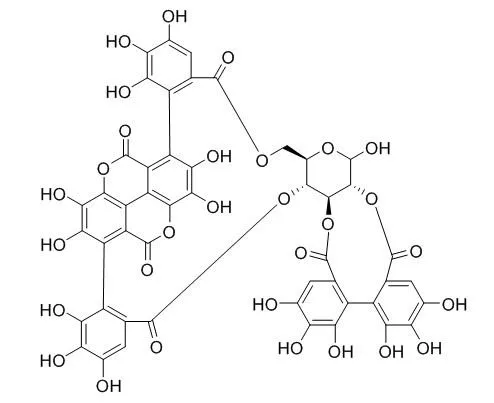| Kinase Assay: |
| J. Funct. Foods, 2013, 5(2):633-41. | | Pomegranate husk extract, punicalagin and ellagic acid inhibit fatty acid synthase and adipogenesis of 3T3-L1 adipocyte[Reference: WebLink] | Fatty acid synthase (FAS) has been recognized as a potential therapeutic target for obesity.
METHODS AND RESULTS:
In this study, for the first time, the inhibitory effect of pomegranate husk extract, Punicalagin and ellagic acid on FAS was investigated.
We found them potently inhibiting the activity of FAS with half-inhibitory concentration values (IC50) of 4.1 mu g/ml (pomegranate husk extract), 4.2 mu g/ml (4.50 mu M, Punicalagin) and 1.31 mu g/ml (4.34 mu M, ellagic acid), respectively. Moreover, they all exhibited time-dependent inactivation of FAS. Punicalagin and ellagic acid inhibited FAS with different mechanisms compared to previously reported inhibitors, through inactivating acetyl/malonyl transferase and beta-ketoacyl synthase domains, respectively. Additionally, 100 mu g/ml pomegranate husk extract, 5.24 mu g/ml (5 mu M) Punicalagin and 4.5 mu g/ml (15 mu M) ellagic acid effectively reduced lipid accumulation inside FAS over-expressed 3T3-L1 adipocytes.
CONCLUSIONS:
Since FAS plays a key role in the biosynthesis pathway of fatty acid, these findings suggest that pomegranate husk extract, Punicalagin and ellagic acid have potential in the prevention and treatment of obesity.
|
|
| Cell Research: |
| Inflammation. 2014 Jun;37(3):956-65. | | Punicalagin inhibits inflammation in LPS-induced RAW264.7 macrophages via the suppression of TLR4-mediated MAPKs and NF-κB activation.[Pubmed: 24473904 ] | Punicalagin (2,3,hexahydroxydiphenoyl-gallagyl-D-glucose and referred to as PUN) is a bioactive ellagitannin isolated from pomegranate, which is widely used for the treatment of inflammatory bowel disease (IBD), diarrhea, and ulcers in Chinese traditional medicine.
METHODS AND RESULTS:
In this study, we detected the anti-inflammation potentials of PUN in lipopolysaccharide (LPS)-induced macrophages and tried to uncover the underlying mechanism. Results demonstrated that PUN (25, 50, or 100 μM) treatment could significantly decrease the LPS-induced production of nitric oxide), prostaglandin E2 (PGE2), interleukin (IL)-1β, IL-6, and tumor necrosis factor (TNF)-α in RAW264.7 cells. Molecular research showed that PUN inhibited the activation of upstream mediator nuclear factor-κB by suppressing the phosphorylation of IκBα and p65. Results also indicated that PUN could suppress the phosphorylation of mitogen-activated protein kinase including p38, c-Jun N-terminal kinase, and extracellular signal-regulated kinase.
CONCLUSIONS:
In conclusion, we observed that PUN could inhibit LPS-induced inflammation, and it may be a potential choice for the treatment of inflammation diseases. |
|
| Animal Research: |
| Mol Cell Biochem. 2015 Apr;402(1-2):141-8. | | Punicalagin attenuated cerebral ischemia-reperfusion insult via inhibition of proinflammatory cytokines, up-regulation of Bcl-2, down-regulation of Bax, and caspase-3.[Pubmed: 25555468] | Punicalagin (PG) is a hydrolysable tannin compound found in Punica granatum L. The purpose of the present work is to explore the neuroprotective mechanism of Punicalagin against ischemia-reperfusion (I/R) injury in rat model of middle cerebral artery occlusion (MCAO).
METHODS AND RESULTS:
Rats were randomly divided into sham, MCAO, and PG-treated groups. Punicalagin (15 and 30 mg/kg), the vehicle was administered orally for 7 days prior to MCAO. Rats were anesthetised with ketamine (100 mg/kg/im), xylazine (10 mg/kg/im) and subjected to 2 h occlusion and 22 h reperfusion. The effects of Punicalagin on behavioral deficit and infarct volume, the levels of glutamate and calcium as well as the levels of inflammatory cytokines tumor necrosis factor-α (TNF-α), interleukin-1β (IL-1β), interleukin-6 (IL-6) were evaluated. Moreover, the expressions of caspase-3, Bcl-2, and Bax were detected by Western blotting. As compared with MCAO group, Punicalagin-treated rats showed dose-dependent reduction in infarct volume and substantial improvement in behavioral deficit. The levels of glutamate, calcium, TNF-α, IL-1β, and IL-6 were restored significantly. The Western blotting results revealed that the expression of Bcl-2 was up-regulated and that of caspase-3, Bax were down-regulated when exposed to Punicalagin.
CONCLUSIONS:
From our results, it can be concluded that Punicalagin showed an ameliorative effect against cerebral I/R injury in rats through its anti-inflammatory, antioxidant actions besides it inhibits excitotoxicity. It also suppresses apoptosis through regulating, Bcl-2, caspase-3, and Bax protein expressions, perhaps another mechanism by which Punicalagin employs its neuroprotective action. | | J Stroke Cerebrovasc Dis. 2014 Nov-Dec;23(10):2869-78. | | Neuroprotective effect of punicalagin against cerebral ischemia reperfusion-induced oxidative brain injury in rats.[Pubmed: 25282190] | Punicalagin (PG) is a hydrolyzable polyphenol in Punica granatum. It has been previously reported that it has a protective effect against hypoxia-induced ischemia brain injury. It is a potent antioxidant. The present study is aimed to evaluate the antioxidant potential of Punicalagin against focal cerebral ischemia-reperfusion injury in rats subjected to middle cerebral artery occlusion (MCAO).
METHODS AND RESULTS:
Rats were randomly divided into sham, MCAO, Punicalagin -treated groups. Punicalagin (15 and 30 mg/kg) vehicle was administered orally for 7 days before MCAO. Rats were anesthetized with ketamine (100 mg/kg), xylazine (10 mg/kg), and subjected to 2 hours occlusion, and 22 hours reperfusion. Neurologic deficit, brain water content (BWC), histopathology changes, and oxidative stress markers were evaluated after 22 hours of reperfusion. In comparison with MCAO model group, treatment with Punicalagin significantly reduced the neurologic deficit scores and BWC. Punicalagin -attenuated neuronal damage occurred by downregulating the levels of malondialdehyde, sodium-potassium adenosine triphosphatase activity, nitric oxide, protein carbonyl content, and mitochondria-generated reactive oxygen species and upregulating the superoxide dismutase, catalase, glutathione peroxidase, reduced glutathione, glutathione reductase activities.
CONCLUSIONS:
Taken together, these results suggested that supplementation of Punicalagin treatment effectively ameliorates the cerebral ischemia/reperfusion induced oxidative damage by virtue of its antioxidant potential. |
|






 Cell. 2018 Jan 11;172(1-2):249-261.e12. doi: 10.1016/j.cell.2017.12.019.IF=36.216(2019)
Cell. 2018 Jan 11;172(1-2):249-261.e12. doi: 10.1016/j.cell.2017.12.019.IF=36.216(2019) Cell Metab. 2020 Mar 3;31(3):534-548.e5. doi: 10.1016/j.cmet.2020.01.002.IF=22.415(2019)
Cell Metab. 2020 Mar 3;31(3):534-548.e5. doi: 10.1016/j.cmet.2020.01.002.IF=22.415(2019) Mol Cell. 2017 Nov 16;68(4):673-685.e6. doi: 10.1016/j.molcel.2017.10.022.IF=14.548(2019)
Mol Cell. 2017 Nov 16;68(4):673-685.e6. doi: 10.1016/j.molcel.2017.10.022.IF=14.548(2019)